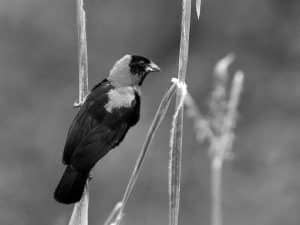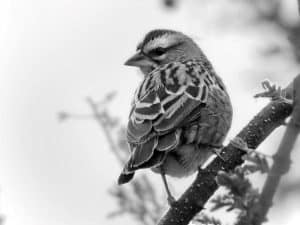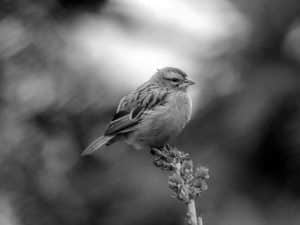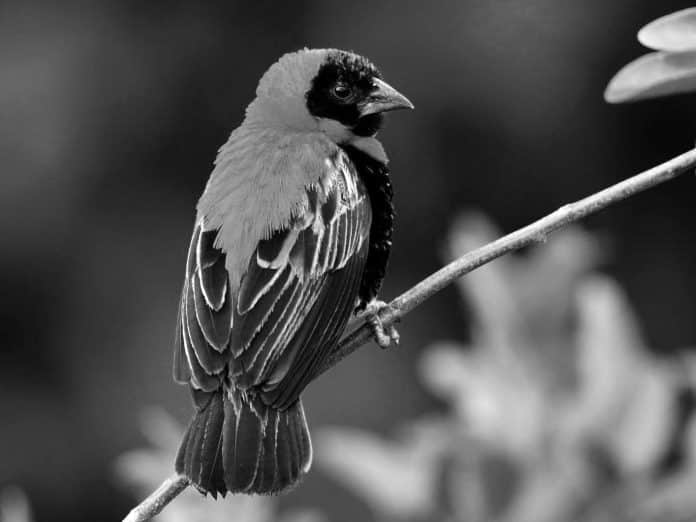Introduction to the Black Bishop Bird
The black bishop, scientifically known as Euplectes gierowii, is a captivating species of weaver bird found in the lush landscapes of Tanzania. This stunning avian resident has captured the hearts of birdwatchers and nature enthusiasts alike, thanks to its striking plumage and intriguing behaviors. As you delve into the world of the black bishop in Tanzania, you’ll uncover a fascinating tale of this avian elegance.
Physical Characteristics and Behavior of the Black Bishop

The black bishop is a medium-sized bird, with a body length ranging from 15 to 18 centimeters. During the breeding season, the male birds display a striking all-black plumage, complemented by a vibrant red shoulder patch and a distinctive black bill. The females, on the other hand, exhibit a more subdued olive-brown coloration, making it easier for them to blend into their surroundings.
These birds are known for their acrobatic aerial displays, often seen fluttering and flitting among the reeds and vegetation. Their melodious calls, a combination of whistles and trills, can be heard echoing through the wetlands and grasslands they inhabit. The black bishop’s social nature is evident in their tendency to form large flocks, particularly during the non-breeding season, adding to the visual spectacle of their presence.
Habitat and Distribution of the Black Bishop in Tanzania
The black bishop is widely distributed throughout Tanzania, with its preferred habitat being the lush wetlands, marshes, and grasslands that dot the country’s diverse landscape. These areas provide the birds with an abundance of food sources, such as seeds, insects, and aquatic invertebrates, as well as suitable nesting sites among the reeds and tall grasses.
In Tanzania, the black bishop can be found in various regions, including the Serengeti National Park, the Ngorongoro Conservation Area, and the Selous Game Reserve. These protected areas not only offer a safe haven for the black bishop but also provide visitors with the opportunity to witness the bird’s captivating presence in its natural environment.
Breeding and Nesting Habits of the Black Bishop
The breeding season of the black bishop typically coincides with the onset of the rainy season, which in Tanzania can vary depending on the region. During this time, the male birds undergo a remarkable transformation, shedding their drab non-breeding plumage in favor of their striking all-black attire with the vibrant red shoulder patches.
The males then engage in elaborate courtship displays, including aerial acrobatics and vocalizations, in an effort to attract potential mates. Once a pair is formed, they work together to construct a dome-shaped nest, often woven from reeds and grasses, and situated in the dense vegetation of their wetland habitat.
The female black bishop lays a clutch of 2-4 eggs, which she incubates for approximately 12-14 days. The chicks hatch and are then cared for by both parents, with the adults providing food and protection until the young birds are able to fend for themselves.
Importance of the Black Bishop in the Ecosystem
The black bishop plays a crucial role in the delicate balance of the wetland and grassland ecosystems it inhabits. As a seed-eater, the bird helps to disperse and control the growth of various plant species, contributing to the overall diversity and health of the local vegetation.
Additionally, the black bishop serves as an important food source for a variety of predators, including raptors, snakes, and small mammals. This interdependence within the ecosystem highlights the vital position the black bishop occupies, and the need to ensure its continued presence in the natural landscapes of Tanzania.
Threats and Conservation Efforts for the Black Bishop
Despite its widespread distribution, the black bishop faces several threats to its long-term survival. Habitat loss and degradation, due to factors such as agricultural expansion, urbanization, and climate change, pose significant challenges to the species. Additionally, the illegal pet trade and hunting for subsistence have contributed to the decline of black bishop populations in certain areas.
In response to these threats, conservation efforts have been implemented to protect the black bishop and its habitat. Organizations and government agencies in Tanzania have worked to establish protected areas, promote sustainable land-use practices, and raise awareness about the importance of this avian species. Through collaborative efforts and ongoing research, the long-term survival of the black bishop in Tanzania remains a priority.
Interesting Facts about the Black Bishop in Tanzania

- The black bishop is known for its remarkable ability to change its plumage color, transitioning from a drab non-breeding appearance to a striking all-black breeding attire.
- These birds are highly social and often form large flocks, particularly during the non-breeding season, adding to the visual spectacle of their presence in the Tanzanian landscape.
- The black bishop’s nest is a remarkable feat of engineering, with the males and females working together to construct a domed structure woven from reeds and grasses.
- In some Tanzanian cultures, the black bishop is revered for its beauty and is often featured in traditional artwork and textiles.
Tips for Birdwatching and Spotting the Black Bishop in Tanzania
If you’re planning a birdwatching adventure in Tanzania, here are some tips to help you spot the elusive and captivating black bishop:
- Visit wetland and grassland habitats: The black bishop is most commonly found in areas with abundant vegetation, such as marshes, swamps, and tall grass meadows.
- Time your visit: The best time to observe the black bishop is during the breeding season, typically from November to April, when the males are in their striking breeding plumage.
- Look for flocks: The black bishop is a social bird, so scanning the vegetation for large groups or flocks can increase your chances of spotting them.
- Listen for their calls: The black bishop’s melodious whistles and trills can often be heard before the birds are seen, so be attentive to their vocalizations.
- Patience and persistence: Birdwatching requires a keen eye and a patient approach. Spend time observing the habitat, and be prepared to wait patiently for the black bishop to make an appearance.
Other Bird Species Found in the Same Habitat as the Black Bishop
The wetlands and grasslands of Tanzania are home to a diverse array of avian species, many of which can be found in the same habitats as the black bishop. Some of the notable birds that share this environment include:
- Wattled Lapwing (Vanellus senegallus)
- Malachite Kingfisher (Alcedo cristata)
- Yellow-billed Stork (Mycteria ibis)
- African Jacana (Actophilornis africanus)
- Black-headed Heron (Ardea melanocephala)
These species, along with the captivating black bishop, contribute to the rich birdlife and ecological diversity of Tanzania’s natural landscapes.
Conclusion: Appreciating the Beauty of Tanzania’s Avian Elegance

The black bishop, with its striking plumage and captivating behaviors, is a true testament to the avian elegance that graces the landscapes of Tanzania. As you explore the wetlands and grasslands of this remarkable country, take the time to observe and appreciate the presence of this remarkable bird species.

































